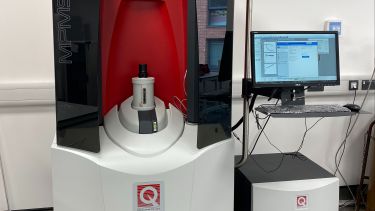Magnetostrictive materials have a large response to external strain or applied field, which allows them to be used as sensors or actuators in structural health monitoring, Internet of Things and healthcare sectors. Additive Manufacturing (AM) allows tunable performance and flexibility in designs, which creates a natural lead to further explore the printing process and design for magnetostrictive materials.
Using AM with magnetic materials is a relatively new area of research. The Desktop Metal 3D printer is a solid-state, extrusion based system that uses a blended polymer/metal feedstock to print a ‘green’ part, which is further processed to remove the polymer and achieve a solid metal part in excess of 99% density. This avoids using excessive heat, and allows accurate printing design.
This project investigated the use of stainless steel 17/4 ph, a soft magnetic material ideal for smart applications due to its low coercivity and high saturation magnetisation. Using the Desktop Metal 3D printer, a range of parts were printed to achieve triangular honeycombs with varying feature sizes.
The Superconducting Quantum Interference Device (SQUID) Magnetometer was used to measure the hysteresis loop at each stage of the printing process; during injection moulding, as-printed and the final sintered steel part. Both the coercivity and saturation magnetisation were measured, and noted a 12.6% lower coercivity alongside a remarkable 18% increase in saturation magnetisation for the final sintered part. Also measured was the directional magnetisation for track prints in the as-printed and sintered steel parts. The anisotropy was shown to be lower in the sintered steel than the as-printed parts due to grain growth, lower porosity and reduction of the polymer material.
The Honeycombs were printed with different track distances so that we could test how this influences the magnetostrictive and magnetic performance using a magnetic camera. The demagnetising field revealed a split positive and negative out-of-plane field, more distinctive in the larger track gap, which may be due to the sintering process where shrinkage is observed.
It was found that the sintered steel had a 54% higher magnetostriction constant compared to that of the as-printed steel.
This project has been invaluable to my PhD degree. I would like to thank the Royce Translational Centre and the University of Sheffield for bringing this project together as I have learnt so much from them
Nisar Ahmed, Doctoral Researcher
Quote attribution...
The ready availability of stainless steel 17/4 ph, intuitive user interface of the Desktop Metal 3D printer, and use of pre-programmed designs means that this mode of production is highly replicable, and ideal for large or small industrial workplaces to adopt and utilise. Magnetostrictive materials are extremely useful in the development of smart devices, therefore being able to manufacture them in an accurate manner would open up further applications where sensors or actuators are required. The discovery of positive and negative out-of-plane fields in the magnetic imaging of our test grid structure shows the future possibility to manipulate the magnetostrictive performance and directional magnetism of AM stainless steel 17/4 ph products.
Nisar graduated in BEng Design with Engineering Materials sandwich degree at Loughborough University in 2019 and joined the Functional Magnetic Materials Group in 2019 as a PhD student at University of Sheffield. His PhD research was on structural health monitoring of carbon fibre by developing an additive manufactured soft magnetic sensor and is set to complete his PhD in late 2023.
Nisar's interest lies in advanced material manufacturing and processing, characterisation of metallic and polymer materials and simulation of smart functional materials using thermal, mechanical and magnetic models. He's currently an associate member of the Institute of Materials, Minerals and Mining (IOM3).
EQUIPMENT USED: Desktop Metal and Superconducting Quantum Interference Device (SQUID) Magnetometer



